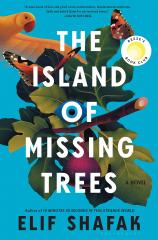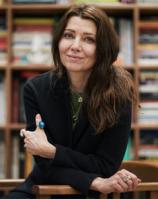Reading Group Guide
Discussion Questions
The Island of Missing Trees

1. When Ada says she felt possessed during her outburst in school, Meryem jumps at the chance to dispel whatever djinn could have invaded Ada’s spirit. But Ada, like her mother, is unconvinced by traditional methods. Meryem, defeated, suggests, “Maybe we give other names to grief because we are too scared to call it by its name” (page 247). Explore how grief appears throughout the book. What or who does each character grieve? How is grief expressed in nontraditional ways? Do you agree with Meryem? And if so, what is so frightening about admitting that we are grieving?
2. Throughout the novel, butterflies appear as a recurring symbol. Butterflies are engraved on the box that Kostas gives to Defne as a token of his love, Ada doodles them absentmindedly before her screaming spell, and it is a butterfly who discovers the grave of Defne and Kostas’ baby during a mass migration to Cyprus. What is the significance of the butterfly’s appearance in these moments? What does this insect symbolize to you and why? Do you see other natural symbols throughout the book? If so, what do they signify?
3. The fig tree often critiques the customs and habits of human beings many take for granted. She notices that though the islanders were rarely united in politics, they share common attitudes of the human experience, including superstitions. She says, “We are scared of happiness, you see” (page 129). She theorizes that especially in cultures that have gone through drastic times of turbulence and trauma people expect every happy moment will be followed by an equal allotment of suffering. Discuss this statement. In your opinion, are humans afraid of happiness? Where does this fear or existential angst originate? How do the characters in this book, human or nature, sabotage or embrace their joy? Do you see this pattern in your own life?
4. In her years, the fig tree meets many animals and insects. A mouse once tells her of the books he munched on in the legendary Ledra Palace, now dilapidated from neglect. A line from Ovid caught his eye: “Some day this pain will be useful to you” (page 307). Examine this quote. Every character in this novel experiences a kind of suffering, sorrow or melancholy. Explore the ways in which each person uses these negative experiences to better understand themselves and contribute to the world. How does our pain transform us in the long run? Can it ever be more than destructive, and can it ever be turned into something more constructive both for us and others? Is there any way pain can be both useful and destructive?
5. Throughout the novel, Shafak reinterprets the concepts of borders and sovereignty, and focuses on those things that do manage to travel beyond borders --- such as migrating birds, the Etesian wind, food and its rituals, superstitions or unexpected bonds of love. Reflecting about the border between Turkish and Greek Cyprus, the Green Line, she draws attention to the color that evokes natural beauty rather than competition or bloodshed. In Kostas’ love letter to Defne, he writes, “I’ve been thinking that you are my country” (page 183). And both Defne and Ada share a commitment to being islanders, rather than Turkish or Greek, Muslim or Christian. What statement is Shafak making about the nature of belonging, humanity and ownership? Are ethnic/national/religious borders necessary or perhaps inevitable, or are they arbitrary? What compels humans to delineate what is ours from what belongs to others? How do Defne and Kostas grapple with these questions?
6. Consider Ada’s scream in the novel’s opening scene. She says, “It felt like I was screaming at everyone --- everything” (page 175). Although she is humiliated by the viral video taken of her, she is equally confused when strangers start taping themselves screaming too and posting #canyouhearmenow in solidarity. Unknowingly, Ada reflected a societal desire shared by both women and youth across the world to be heard. What statements does the novel as a whole make about gender inequality and discrimination? In what ways are women both oppressed by their partners or governments and also triumphant and defiant? Explore the moments in the book where the strength or struggle of women was highlighted.
7. Interconnectedness and symbiosis are important themes for the characters of THE ISLAND OF MISSING TREES. Shafak illustrates the ways in which disparate natural elements intertwine to mutually thrive, how humanity and nature are connected through their reliance on the earth, and how humans are dependent on their histories even as they embark into the future. Discuss moments in the book where these themes are particularly apparent. What can we learn from our human attachment to the natural world? Why are the details of our pasts so important to us? Explore the symbiotic relationships in your life. What human/animal/natural aspects come together to form your everyday world?
8. Defne’s death looms over the novel. Kostas argues that she did not die by suicide but rather was plagued with an invisible illness that inhibited her ability to heal from the past. Like a girdled tree that is “strangled by its own roots,” Defne could not escape her pain nor could she ward it off with love (page 334). Ada wants to blame her mother for not having enough love inside of her to survive. With whom do you agree? In what ways does society prioritize physical pain over that which is psychological?
9. The novel offers many approaches to healing. Defne dedicated her life’s work to unearthing victims of war as a form of reconciliation. In reverse, Kostas buries a fig branch in England to save the tree’s life. Meryem uses tradition as a salve and Ada wants only to know the truth about her past. Defne insists, “We have to remember in order to heal,” and yet forces Kostas to withhold their past from Ada (page 215). Discuss these contradictions. What lesson do these stories impart about the process of healing? Is one form of repair better or worse than another? What lessons could humans learn about healing from acknowledging the ways in which the natural world experiences pain?
10. Cyprus is the novel’s main setting. Those who fled conflict, like Kostas, and those who stayed, like Defne and Meryem, struggle to understand one another. Their mixed feelings of pride, guilt, resentment and sadness can overshadow the grief that they share. Shafak writes, “First-generation immigrants are a species all their own” (page 23). How do the characters in this novel mourn or celebrate their home country? Are any of them able to overcome their loss and, if so, how? How do we say goodbye to the place in which we were rooted?
11. At the end of the novel, we learn that Defne’s spirit transmutes into the fig tree when it leaves her physical body. While Meryem had prayed for Defne’s spirit to enter heaven, Defne explains, “I much preferred to stay where I am, rooted in the earth” (page 342). Discuss this final moment. Why would Defne choose to remain close to the life in which she suffered? What about the natural world is preferable to the human one? What shifts about the way we understand the fig tree’s story, knowing that Defne had embodied her all this time?
12. Explore the novel’s two significant love stories: Yiorgos and Yusuf, and Defne and Kostas. These couples mirror each other in many ways: one Turkish and one Greek, one bold and one timid, and both seeking refuge from a war destined to destroy them. Shafak writes, “Love is the bold affirmation of hope. You don’t embrace hope when death and destruction are in command” (page 168). From years of experience, Yiorgos and Yusuf taught Kostas and Defne how to build a relationship in secret. Discuss how these couples maintained their bond through the presence of fear and intimidation. If trauma can be passed through generations, can love as well?
13. The readers of Shafak’s story rely on the natural world to complete the history of its human characters. Shafak writes, “The human mind was the strangest place, both home and exile. How could it hold onto something as elusive and intangible as a scent when it was capable of erasing concrete chunks of the past, block by block?” (page 200). Trees, comparatively, are “memory keepers” (page 211). When a story is told from many perspectives, how do we, as readers, decipher what is true and what is not? Is it safe to assume that the natural world is unbiased? In your opinion, is the fig tree a narrator or a character? Would it be possible to have the entire story without her?
14. The fig tree acts as interpreter for the animal kingdom and witness to the human storylines. Shafak writes, “Nature was always talking, telling things, though the human ear was too limited to hear them” (page 207). Explore your favorite moments in which the fig tree, or another natural element, attempts to communicate with the humans close by. Are there moments of true communication? If so, when? Did Shafak’s illustration of the fig tree change the way you see the natural world? What forms of nature pay witness to your life? What species are they, and what do you imagine they would say to you?
15. Shafak writes, “Family traumas are like thick, translucent resin dripping from a cut in the bark. They trickle down generations” (page 128). Trees can live for hundreds if not thousands of years, and they continue to collect wisdom throughout their long lives. But humans exist briefly. The trauma they endure compounds on top of the trauma they inherit. Choose a character and discuss how generational trauma has impacted them. How does this inherited pain differ from contemporary suffering, if at all? How do Kostas and Defne navigate their collective trauma as a couple? By the end of the novel, do you think that Ada has had an opportunity to heal?
The Island of Missing Trees
- Publication Date: November 2, 2021
- Genres: Fiction, Women's Fiction
- Hardcover: 368 pages
- Publisher: Bloomsbury Publishing
- ISBN-10: 1635578590
- ISBN-13: 9781635578591







